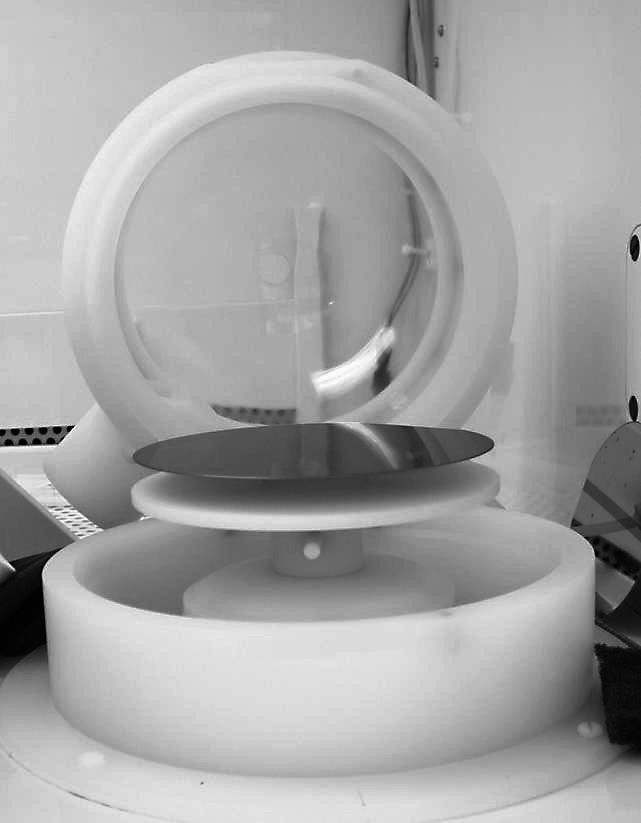spin coating on:
[Wikipedia]
[Google]
[Amazon]
 Spin coating is a procedure used to deposit uniform
Spin coating is a procedure used to deposit uniform
"The limits of edge bead planarization and surface levelling in spin-coated liquid films"
''J. Micromech. Microeng.'' 30, 025003, (2020).
Spin Coating of Thin and Ultrathin Polymer Films
*
Deposition of polymer films by spin casting: A quantitative analysis
Industrial processes Semiconductor device fabrication Thin film deposition {{Industry-stub
 Spin coating is a procedure used to deposit uniform
Spin coating is a procedure used to deposit uniform thin film
A thin film is a layer of material ranging from fractions of a nanometer (monolayer) to several micrometers in thickness. The controlled synthesis of materials as thin films (a process referred to as deposition) is a fundamental step in many a ...
s onto flat substrates. Usually a small amount of coating material is applied on the center of the substrate, which is either spinning at low speed or not spinning at all. The substrate is then rotated at speed up to 10,000 rpm to spread the coating material by centrifugal force
In Newtonian mechanics, the centrifugal force is an inertial force (also called a "fictitious" or "pseudo" force) that appears to act on all objects when viewed in a rotating frame of reference. It is directed away from an axis which is parallel ...
. A machine used for spin coating is called a spin coater, or simply spinner.
Rotation is continued while the fluid spins off the edges of the substrate, until the desired thickness of the film is achieved. The applied solvent is usually volatile, and simultaneously evaporates
Evaporation is a type of vaporization that occurs on the surface of a liquid as it changes into the gas phase. High concentration of the evaporating substance in the surrounding gas significantly slows down evaporation, such as when humidi ...
. The higher the angular speed
Angular may refer to:
Anatomy
* Angular artery, the terminal part of the facial artery
* Angular bone, a large bone in the lower jaw of amphibians and reptiles
* Angular incisure, a small anatomical notch on the stomach
* Angular gyrus, a region ...
of spinning, the thinner the film. The thickness of the film also depends on the viscosity and concentration of the solution, and the solvent. Pioneering theoretical analysis of spin coating was undertaken by Emslie et al., and has been extended by many subsequent authors (including Wilson et al., who studied the rate of spreading in spin coating; and Danglad-Flores et al., who found a universal description to predict the deposited film thickness).
Spin coating is widely used in microfabrication
Microfabrication is the process of fabricating miniature structures of micrometre scales and smaller. Historically, the earliest microfabrication processes were used for integrated circuit fabrication, also known as " semiconductor manufacturing ...
of functional oxide layers on glass or single crystal substrates using sol-gel precursors, where it can be used to create uniform thin films with nanoscale thicknesses. It is used intensively in photolithography, to deposit layers of photoresist about 1 micrometre thick. Photoresist is typically spun at 20 to 80 revolutions per second for 30 to 60 seconds. It is also widely used for the fabrication of planar photonic structures made of polymers.
One advantage to spin coating thin films is the uniformity of the film thickness. Owing to self-leveling, thicknesses do not vary more than 1%. However, spin coating thicker films of polymers and photoresists
A photoresist (also known simply as a resist) is a light-sensitive material used in several processes, such as photolithography and photoengraving, to form a patterned coating on a surface. This process is crucial in the electronic industry.
...
can result in relatively large edge beads whose planarization has physical limits.Arscott, S"The limits of edge bead planarization and surface levelling in spin-coated liquid films"
''J. Micromech. Microeng.'' 30, 025003, (2020).
References
Further reading
* S. Middleman and A.K. Hochberg. "Process Engineering Analysis in Semiconductor Device Fabrication". McGraw-Hill, p. 313 (1993) *External links
*Spin Coating of Thin and Ultrathin Polymer Films
*
Deposition of polymer films by spin casting: A quantitative analysis
Industrial processes Semiconductor device fabrication Thin film deposition {{Industry-stub